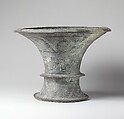Vase with Incised and Impressed Designs
Ban Chiang on the Khorat Plateau in northwest Thailand, one of the most famous archaeological sites in the country, is noted for the production of a wide range of technologically and aesthetically sophisticated ceramics dating from the third millennium B.C. to the third century A.D. As a result, similar works, of unknown provenance, are often attributed to this site. It is possible, however, that many such items were made at related but less well known centers on the plateau or elsewhere in mainland Southeast Asia.
This striking beaker-shaped vessel is typical of works attributed to the earliest phases at Ban Chiang. It was formed in two pieces: a large open-mouthed container with a rounded base that is placed into a shorter pedestal with a broad foot. A prominent flange conceals the seams where the two sections are joined. Covering the entire surface of the vessel, exuberant curvilinear forms were first incised and then further elaborated with impressed decoration. The dark gray color of the vessel is the result of both firing in hot wood first and the glow of oxygen over the vessel as the fire died down. Traces of burnishing are visible on the surface of the vessel, particularly in the interior.
Due to rights restrictions, this image cannot be enlarged, viewed at full screen, or downloaded.

